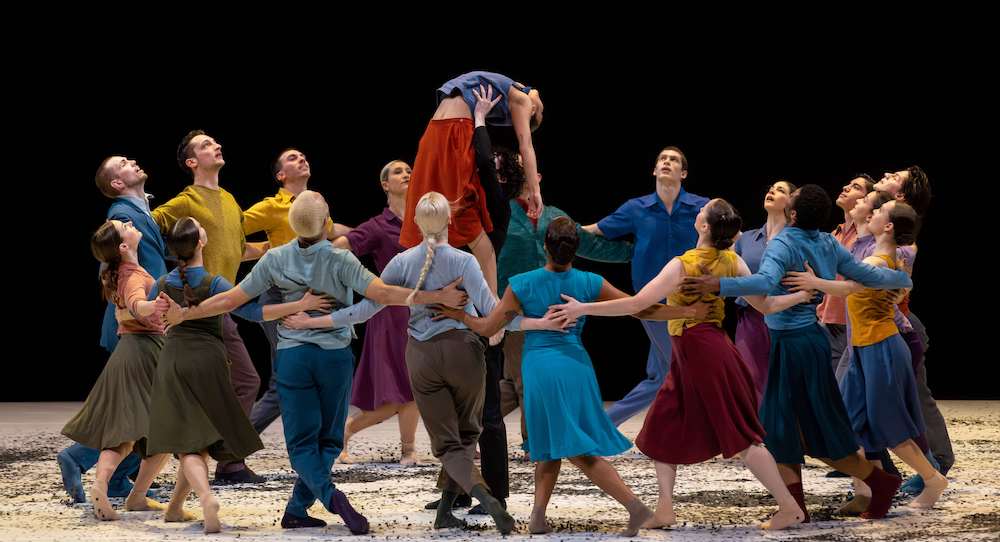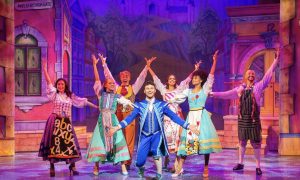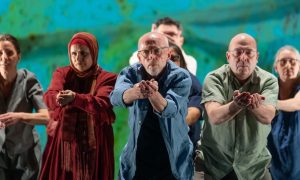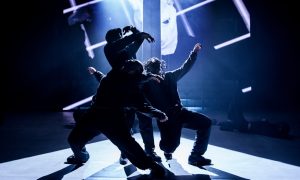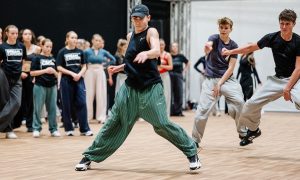Sadler’s Wells Theatre, London.
21 May 2025.
Dance Consortium presented Ballet BC in a Crystal Pite/Johan Inger double bill. It was a fabulous opening for Pite’s Frontier, with dancers clad in loose black clothing, including head and face, oozing up onto the stage from the audience and rolling to the back where they disappeared.
One stayed to dance with a lone female figure dressed in white. The music was choral, the duet fluid and lyrical.
Contrary to its name, Ballet BC is a contemporary creation company, and “Frontier is a portrait of the invisible forces that move us,” says Pite. “I love shadows. A symbol of my unconscious mind, my shadow slides silently with me in perfect unison.”
This statement was echoed perfectly in the first duet. The ‘shadow’ figure was supportive and nurturing, the visual dynamic between light and shade effective. The next duet was a male figure dressed in white, and his ‘shadow’, more confrontational and physical, with fight-like stance and movement.
A reverberating heartbeat, with unintelligible whispers backed this section. I liked the atmosphere and sense of mystery it created. Thunder rumbled and the female in white strode through a line of shadows, who fell as she passed and then formed an intimidating semi-circle around her.
There was use of shadow-play on the backcloth. The sharp and dramatic lighting changes added a lot of depth and perception to this piece. Building to dramatic climax with the billowing and fall of the backcloth; the audience applauded appreciatively. It felt like the end.
But there was a coda – accompanied by more choral music, and all the shadows, using a lot of canon in their movements, melted back off the stage into the audience, the way they had arrived.
The curtain opened on Act Two and PASSING by Johan Inger began. Explained in a pre-show talk, PASSING is a “celebration of humanity”, described as the unstoppable flow of birth, aging and death.
It was a very visual opening as two characters scattered earth on the stage floor to make a winding pathway. Starting on opposite sides of the stage and meeting together in the centre, they seemed to represent an elderly couple. Following behind each of them, a dancer walking along the pathway on demi-pointe, weight back and arms held stiffly in first; the young. They too met each other in the centre and came alive in each other’s arms to the sound of romantic guitar music. It was a relaxed and playful duet with a Spanish feel. It was joyful, comical and in many ways unexpected, culminating in the birth of the next generation.
Dancers entered from beneath the female’s legs from the front wing, accompanied by comically agonised cries from the ‘mother’. The birthed dancers slithered onto the stage, 18 in total and got to their feet following the previous one, then joining hands in a long line and entering a fun, spirited community dance with plenty of folk and national dance elements in it.
This was full of colour and fun to watch. New couples emerged birthing new families, whilst the rhythm of life continued around them. All the while, the tidy earth pathway was swished and swirled across the stage.
This company were not afraid to use their voices, and a very effective part of PASSING was the exaggerated laughter mixed with crying from different trios of dancers who would run onto the stage, meet in the centre and perform a short motif, their laughter or tears as the music. The audience’s reaction was interesting – nervous or awkward at first. As the sound of laughter became infectious, the audience relaxed and laughed along, too.
A solo male dancer lay prone downstage and began to sing a melancholy, reflective song. An elderly couple danced slowly as he sang, holding one another, moving across the back of the stage. A playful younger couple danced, and an irrepressible tap dancer galloped on all fours across the stage. Humour and sentimentality all in one here.
A female character began to sweep at the earth on the ground. One of the elderly dancers collapsed, and she swept him off stage with some of the earth, while his partner continued, still lost in their dance.
In the last section of PASSING, one couple began to remove their outer clothing, as the rest of the cast bustled around them. The couple met in the centre, and sprinkled earth began to fall over the stage like snowflakes. The rest of the dancers gradually also removed their outer clothing until they were all dancing in nude base-layers accompanied by a mesmerising, hypnotic score. They rolled up stage and disappeared – the continuous cycle of life?
We were left at the end, with an empty stage before the curtain fell, which felt an anti-climax. A powerful statement of perceived nothingness at the end of life?
By Louise Ryrie of Dance Informa.


